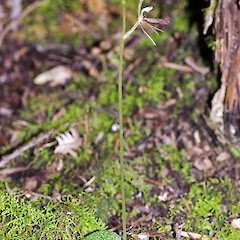Cyrtostylis rotundifolia
Common name
winter orchid
Synonyms
Acianthus reniformis (R.Br.) Schltr.
Family
Orchidaceae
Flora category
Vascular – Native
Endemic taxon
Indeterminate
Endemic genus
Yes
Endemic family
No
Structural class
Orchids
NVS code
The National Vegetation Survey (NVS) Databank is a physical archive and electronic databank containing records of over 94,000 vegetation survey plots - including data from over 19,000 permanent plots. NVS maintains a standard set of species code abbreviations that correspond to standard scientific plant names from the Ngä Tipu o Aotearoa - New Zealand Plants database.
CYRROT
Chromosome number
2n = 44+2
Current conservation status
The conservation status of all known New Zealand vascular plant taxa at the rank of species and below were reassessed in 2017 using the New Zealand Threat Classification System (NZTCS) – more information about this can be found on the NZTCS website. This report includes a statistical summary and brief notes on changes since 2012 and replaces all previous NZTCS lists for vascular plants.
Please note, threat classifications are often suggested by authors when publications fall between NZTCS assessment periods – an interim threat classification status has not been assessed by the NZTCS panel.
- Conservation status of New Zealand indigenous vascular plants, 2017 . 2018. Peter J. de Lange, Jeremy R. Rolfe, John W. Barkla, Shannel P. Courtney, Paul D. Champion, Leon R. Perrie, Sarah M. Beadel, Kerry A. Ford, Ilse Breitwieser, Ines Schönberger, Rowan Hindmarsh-Walls, Peter B. Heenan and Kate Ladley. Department of Conservation. Source: NZTCS and licensed by DOC for reuse under the Creative Commons Attribution 4.0 International licence.
2017 | Not Threatened
Previous conservation statuses
2012 | Not Threatened
2009 | Not Threatened
2004 | Not Threatened
Distribution
Indigenous. New Zealand: North Island (southern two-thirds), South Island (confined to the upper half, mainly in North-west Nelson).
Habitat
Coastal to lower montane in open clay pans or lightly shaded scrub. May be found amongst mosses on basalt rock. Most commonly found in shallow leaf litter amongst sparse mosses or hard, exposed clay soils.
Detailed description
Winter to spring flowering perennial herb. Plants at flowering up to 100 mm tall (usually less), elongating in seed. Stem erect, slender. Leaf sessile, almost basal, 10–40 × 8–17 mm, grey-green with whitish veins above, pale silvery green below, ovate, obtuse to subacute, base cordate to rounded. Inflorescence a raceme up to 30 mm long; floral bracts diminutive, membranous. Flowers 1–4; perianth 8–10 mm long, spreading, pink or pinkish-green. Sepals subequal; dorsal sepal narrow linear-lanceolate, obtuse, erect, concave; lateral sepal narrow-linear, acute, projecting forwards or widely spreading. Petals similar to lateral sepals. Labellum 10 × 4 mm, oblong; apex obtuse, not recurved, projecting horizontally forwards, the adjacent margins toothed; surface more or less plane, lamina bearing two prominent, spheroidal basal calli and two, flat, longitudinal ridges that extend nearly to the apex. Column shorter than the labellum, conspicuous; wings narrow below, widening above so that the stigma is flanked by two lobes. Pollinia two per anther cell, more or less ellipsoid to tabular, some what crescent-shaped, crumbling readily in single grains.
Manaaki Whenua Online Interactive Key
Similar taxa
Most likely to be confused when vegetative with species of spider orchid (Corybas) from which it is not easily distinguished unless bearing flower buds, which are multiple in a raceme, rather than mostly solitary, rarely in pairs. From Cyrtostylis oblonga it differs by its grey-green rather than yellow-green to green ovate rather than oblong leaf. Other distinctions are less clear and the status of these two species requires further investigation. C. rotundifolia could be confused with Acianthus sinclairii from which it differs by its preference for more open habitats, and by having sessile leaves held close to or at the base of the stem and lying on or very close to the ground, and the labellum is larger, oblong, rather than ovate, and the petals are as long as, or longer than the lateral sepals, rather than much shorter. The very uncommon Townsonia deflexa is similar to both Cyrtostylis species but occupies very different forest habitats and it forms interconnected creeping patches. Townsonia deflexa has a much smaller, petiolate leaf distinct from the flowering stem which supports a small, orbicular rather than ovate cauline leaf, otherwise this species has flowers very similar to those of other Cyrtostylis and indeed Acianthus.
Flowering
June–October
Flower colours
Green, Red/Pink
Fruiting
October–January
Propagation technique
Difficult—should not be removed from the wild.
Etymology
cyrtostylis: Curved style
rotundifolia: Round leaf; from the Latin rotundus and folium
Where To Buy
Not commercially available.
Taxonomic Notes
Long regarded as either Acianthus reniformis or Cyrtostylis reniformis. Based on a mostly unpublished molecular (nrITS based study) and limited chromosomal evidence Cyrtostylis reniformis is now regarded as an Australian endemic (B.P.J. Molloy pers. comm.). New Zealand plants treated under that name have been referred to Cyrtostylis oblonga Hook.f. and C. rotundifolia (B.P.J. Molloy pers. comm.), however, Paul Kores (pers. comm.) on the basis of critical multi-marker DNA and morphological based studies of Acianthus and it allies treats Cyrtostylis as a synonym of Acianthus and does not recognise two species for New Zealand. More recently, an as yet unpublished (now in press) study of the Australian and New Zealand Orchidaceae has shown that Cyrtostylis is not allied to Acianthus but rather is sister to Corybas (which as circumscribed there now includes the segregate genera Anzybas, Nematoceras, Singularybas and Molloybas) (P. Weston pers. comm. November 2014).
Attribution
Fact Sheet prepared for NZPCN by P.J. de Lange 14 April 2007: Description adapted from Moore and Edgar (1970).
References and further reading
Moore LB, Edgar E. 1970. Flora of New Zealand, Volume II. Indigenous Tracheophyta: Monocotyledones except Gramineae. Government Printer, Wellington, NZ. 354 p.
NZPCN Fact Sheet citation
Please cite as: de Lange, P.J. (Year at time of access): Cyrtostylis rotundifolia Fact Sheet (content continuously updated). New Zealand Plant Conservation Network. https://www.nzpcn.org.nz/flora/species/cyrtostylis-rotundifolia/ (Date website was queried)












